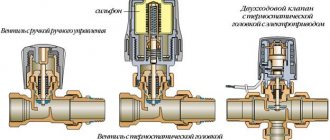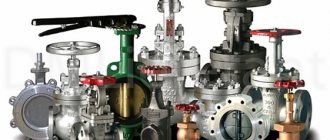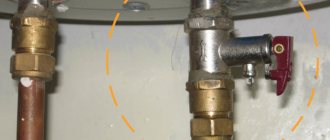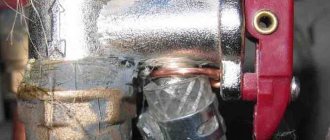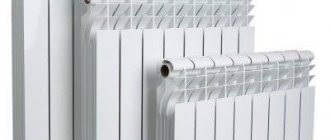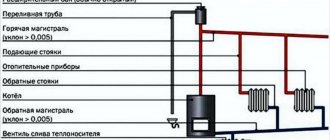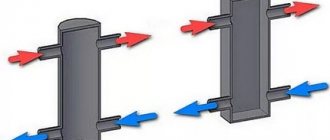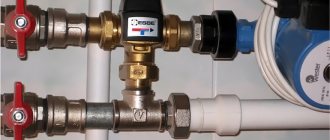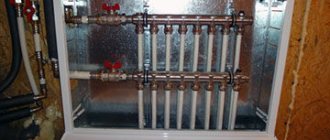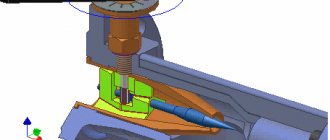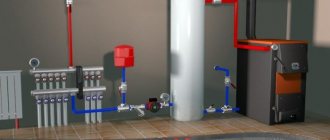Why are there taps on radiators?
Each heating device is a separate element of the system that requires adjustment and periodic maintenance. If you control the coolant flow through the batteries depending on the heat demand, you can achieve good results in terms of energy savings. That is, radiator valves and heating taps are designed to solve the following problems:
- Complete isolation of the heating device from the system.
- Restriction of coolant flow through the battery.
- Change in coolant flow depending on external conditions.
- Bleeding air from the radiator and piping network.
There are many situations in which it is difficult to do without disconnecting the battery. For example, properly working central heating in the middle of spring, when it’s already warm outside, but it’s just hot in the apartment. Another case is the need to remove a heating device for the purpose of replacement, flushing or repair. In the absence of shut-off valves, carrying out any action with the radiator becomes problematic.
Valves are also installed on batteries in retro style
Restriction of the flowing coolant is carried out in order to balance individual heating in a private house or apartment. No matter what type of heating system you have, without balancing with valves, the first radiators will always receive more water than the last ones. Limiting the coolant flow at the beginning of the network and thereby balancing all devices with each other is the task of the control radiator fittings.
Automatic control of the flow of incoming coolant is a way to save energy used to heat the house. If each tap on the heating radiator maintains the set air temperature in the room by controlling the flow of water through the radiator, then in general the system will consume only the required amount of heat, no more. And this is a considerable saving.
Well, the problem of air release when filling the system or during operation is also solved by special air valves installed on all modern radiators. Below is a list of types of shut-off and control valves, listed in the same order as the tasks they solve:
- Half-turn ball valves in straight and angle versions. Made from brass, bronze or polypropylene with a metal insert.
- Balancing valves for radiators – straight and angular.
- Regulating valves with thermal heads (thermostatic valves).
- Air drain valves – automatic and manual.
For reference. Some home craftsmen use three-way mixing valves to connect heating appliances. But such a solution is unreasonably expensive and is rarely used in practice.
Now we should consider in detail which taps are best installed on radiators in various conditions and circumstances. Some options are clearly shown in the video:
Why are cranes needed?
First of all, it should be said that people commonly call a faucet any device for controlling the flow of liquid that has a handle. Technically, it is more correct to call taps shut-off valves.
Moreover, the latter only allows you to completely shut off or open the coolant flow, but not to regulate its flow. Valves and valves are used for regulation.
As a rule, control valves are installed at the entrance to the radiator, which performs the following functions:
- Allows you to disconnect the battery, which may be necessary for various reasons.
- Allows you to shut off the coolant for washing the device or inspection.
- In manual or automatic mode, it regulates the flow of coolant and thereby the temperature of the radiator.
It should be taken into account that different types of fittings may have different functions. Below we will get acquainted with the features and design of all types of taps that are used in conjunction with radiators of the heating system.
Installation of ball valves on batteries
A conventional ball valve is designed only to switch to 2 positions: “open” and “closed”. It cannot be used to regulate the flow of coolant through the radiator, only shut it off. The figure below shows a simple connection diagram for a heating device with this type of fittings:
The proposed scheme is the best option for an unregulated connection of a radiator to the central heating risers in an apartment. You won’t have to balance it anyway, and installing a thermostatic valve is pointless due to the poor quality of the coolant. Instead of a ball valve at the outlet, it is also practiced to install a so-called shut-off valve; its difference is only in appearance.
Depending on the layout of appliances and heating pipes, you can choose an angle valve for a radiator with or without a decorative coating. Also, when choosing a product, it is recommended to pay attention to the operating pressure indicated on the product body or in its passport. It must correspond to the pressure in the heating network of the apartment building.
Advice. For installation on the radiator, choose good taps made of thick-walled brass and a connection with an American union nut. It will allow you to quickly disconnect the connections without rotating the elements. On a single-pipe riser, do not forget to install the bypass with a slight offset away from the main pipe.
Automatic adjustment
Automatic maintenance of room temperature is good because once you set the control knob to the desired position, you will get rid of the need to twist and change something for a long time. The temperature of the heating radiators is adjusted constantly and continuously. The disadvantage of such systems is their significant cost, and the more functionality, the more expensive the device will be. There are some other features and subtleties, but more on them below.
Adjusting radiators with thermostats
To maintain a constant set temperature in a room (room), thermostats or thermostats for heating radiators are used . Sometimes this device may be called a “thermostatic valve”, “thermostatic valve”, etc. There are many names, but one device is meant. To make it clearer, it is necessary to explain that the thermal valve and thermal valve are the lower part of the device, and the thermal head and thermoelement are the upper part. And the entire device is a radiator thermostat or thermostat.
This is what the thermostat on the radiator looks like
Most of these devices do not require any power source. The exception is models with a digital screen: batteries are inserted into the thermostatic head. But their replacement period is quite long, the current consumption is low.
Structurally, the radiator thermostat consists of two parts:
- thermostatic valve (sometimes called “housing”, “thermal valve”, “thermal valve”);
- thermostatic head (also called “thermostatic element”, “thermoelement”, “thermal head”).
The valve itself (body) is made of metal, usually brass or bronze. Its design is similar to that of a manual valve. Most companies make the lower part of the radiator thermostat unified. That is, heads of any type and any manufacturer can be installed on one body. Let us clarify: you can install a manual, mechanical, or automatic thermocouple on one thermal valve. It is very comfortable. If you want to change the adjustment method, you do not need to buy the entire device. They installed another thermostatic element and that was it.
The difference between a manual radiator regulator and an automatic one is only in the installed thermal head
In automatic regulators, the principle of influencing the shut-off valve is different. In a manual regulator, its position is changed by turning the handle; in automatic models there is usually a bellows that presses on the spring-loaded mechanism. In electronic devices, everything is controlled by the processor.
The bellows is the main part of the thermal head (thermoelement). It is a small sealed cylinder containing liquid or gas. Both liquid and gas have one thing in common: their volume is highly dependent on temperature. When heated, they significantly increase their volume, stretching the bellows cylinder. It puts pressure on the spring, blocking the flow of coolant more strongly. As it cools, the volume of gas/liquid decreases, the spring rises, the coolant flow increases, and heating occurs again. This mechanism, depending on the calibration, allows you to maintain the set temperature with an accuracy of 1 o C.
Watch the video to see how the thermostat works.
The radiator thermostat can be:
- with manual temperature control;
- with automatic;
- with built-in temperature sensor;
- with remote (wired).
There are also special models for one-pipe and two-pipe systems, housings made of different metals. Read more about radiator thermostats here.
Using Three-Way Valves
A three-way valve is rarely used to regulate battery temperature. He has a slightly different task. But in principle, it is possible.
By installing a three-way valve on the supply side, you can also regulate the coolant temperature
A three-way valve is installed at the junction of the bypass and the supply pipe going to the radiator. To stabilize the temperature of the coolant, it must be equipped with a thermostatic head (of the type described above). If the temperature near the head of the three-way valve rises above the set value, the flow of coolant to the radiator is blocked. It all rushes through the bypass. After cooling, the valve operates in the opposite direction and the radiator heats up again. This connection method is implemented for single-pipe systems, more often with vertical wiring.
Balancing valve
The design of a valve for regulating heating differs from a conventional ball valve in that it can smoothly close the flow area in a few turns. Moreover, after balancing, the position of the valve can be fixed so that no one accidentally violates the settings. This type of control valves is installed at the outlet of the radiator, as shown in the diagram:
Shown here is the connection to a two-pipe horizontal system, most common in private houses and apartments with individual heating. By the way, the principle of installing fittings with a single-pipe scheme remains the same. A regular ball valve is installed on the supply line, and an adjustment valve is installed on the return line. In the case when a two-story house has a system with vertical risers, the installation diagram of the accompanying fittings looks like this:
The principle of product selection is the same as in the previous section. Straight or angular design is accepted depending on the layout of the equipment and pipelines; it is also important to use American ones during assembly. Pay special attention to the quality of casting and the thickness of the brass walls of the fittings. If you have networks made of polypropylene pipes, do not rush to buy PPR taps; it is better to install adapters and reliable metal products.
Advice. Balancing valves are installed on all radiators, except for the very last one, located at the dead end of the branch. It is enough to install simple ball valves on the connections to it.
How to increase the heat dissipation of batteries
Whether it is possible to increase the heat transfer of a radiator depends on how it was calculated and whether there is a power reserve. If the radiator simply cannot produce more heat, then any means of adjustment will not help. But you can try to change the situation in one of the following ways:
- First of all, check for clogging of filters and pipes. Blockages are not only found in old houses. They are more often observed in new ones: during installation, various types of construction debris enter the system, which clogs the devices when the system is started. If cleaning does not produce results, we move on to drastic measures.
- Increase the coolant temperature. This is possible with individual heating, but it is very difficult, rather impossible, with centralized heating.
- Change connection. Not all types of radiator connections are equally effective, for example, reverse side connection results in a 20-25% reduction in power, and the installation location of the heating device also affects it. Read more about battery connection types here.
- Increase the number of sections. If the connection and installation are optimal, but the room is still not warm enough, it means that the heating power of the heating device is not enough. Then you need to grow several sections. Read how to do this here.
Adjusting the radiator temperature will not raise it
The main disadvantage of adjustable systems is that they require a certain power reserve of all devices. And these are additional funds: each section costs money. But I don’t mind paying for comfort. If your room is hot, life is not a joy, just like if it is cold. And control valves are a universal way out of the situation.
There are many devices that can change the amount of coolant flowing through a heating device (radiator, register). There are very inexpensive options, and there are decent ones. Available with manual, automatic or electronic adjustment. Let's start with the cheapest ones.
Using valves with thermal heads
These are the best taps that can be installed on radiators in the heating system of a private home. Tuned to a certain air temperature, the thermal head acts on the valve stem, forcing it to open or close its flow area. In this way, automatic quantitative regulation of the coolant passing through the heating device occurs.
The thermostatic valve is installed on the supply line to the battery, and a balancing valve is installed on the return line. It is a mistake to assume that the system will be automatically balanced by thermal heads; valves are needed in any case. Installation of conventional ball valves instead of them is allowed for centralized heating or in systems with associated coolant movement (Tichelman loop). But it is unacceptable to regulate the coolant flow using a ball valve, and it will not work.
Advice. Most models of thermal valves have a mechanical blocking mode for the flow area. If you received products without such a mode, then to service the battery you will have to install an additional cut-off device, as shown in the diagram:
Classification of species
The products under consideration are divided into regulating (helping to coordinate the intensity of the flow) and shut-off (blocking and releasing the coolant flow). According to the professional classification, the category of faucets includes only shut-off models, while regulating variations are represented by gates and valves. But in everyday life, taps refer to all types of fittings installed on batteries.
Heating radiators are equipped with:
- locking mechanisms, for example, a half-turn ball valve;
- balancing valves;
- fittings intended for the removal of coolant;
- air release valves. Here the brightest representatives are automatic air vents, Mayevsky crane;
- adjustment models with thermal heads.
Mayevsky tap
The latter are sold in the form of thermostatic valves.
Characteristics of shut-off valves
When equipping a heating system with radiators, it is recommended to install either a pair of ball valves or install an adjustment valve on the return line. With the help of shut-off valves in the form of ball valves, it is possible to dismantle the batteries (provided the flow of working fluid is blocked) without completely removing the coolant from the system.
The steel ball is the basic operating element; it has a hole through which the working fluid flows. It is fixed on the rod, as a result, when the handle is turned at a right angle, the ball becomes in such a position that the flow of the medium is completely stopped.
Products can be made of silumin, brass, polypropylene, they are divided into angular and straight variations. Full bore models have a hole as close as possible to the diameter of the pipeline, while for standard models this figure is no more than 80%. In the first case, optimal heat transfer from heating devices is ensured.
Air release mechanisms
Using the Mayevsky tap, air pockets are removed from the radiators. As an alternative, automatic air vents can be used, but they are less aesthetically pleasing than the traditional option.
The body of the Mayevsky tap is made of polymers; the washer soldered into it has a thread laid along a cone-shaped through hole. Using a special key or a recess into which a screwdriver is inserted, you can unscrew and screw in the cone.
The air plugs come out through a hole in the plastic washer on the body: a key or screwdriver is placed in the provided groove, rotated so that water flows, then the cone is screwed into place until it stops. It is forbidden to completely unscrew the cone, otherwise you will not be able to put it back due to the pressure in the system.
Balancing valves
The products are designed to adjust the temperature regime produced by heating circuits. If the battery is not equipped with a thermostatic valve, it is permissible to use a control valve operating in mechanical mode: here the flow area dimensions are manually entered based on the pressure level in the pipe before and after the control valve for heating.
Balancing valves
In those systems where thermostatic valves are responsible for changing the operating temperature range of radiators, the automatic valve also performs pressure balancing. All units in this category are installed on the return line.
Control valves
The thermostatic valve allows you to regulate the temperature in the room. The thermal head adjustment can be automatic or manual; it causes a displacement of the valve rod, thereby controlling the diameter of its flow section. If the thermal valve is not intended to block the flow of the working medium, an additional shut-off valve for the heating system is installed, which is necessary for full maintenance of the radiator.
A three-way control valve for heating is capable of redistributing liquids in the system (diluting too hot liquids in the circuit with cooled ones from the return), due to this the temperature regime in the room changes. The metal body of the three-way model contains a valve with passage channels. There are three pipes - for hot, cold coolant and its outlet. The product is made of steel, brass, cast iron, the second option is more common. Installation of a three-way heating valve can be flanged, welded, or using couplings.
Coolant drain solutions
Installing flushing taps on radiators makes it easy to drain the coolant as part of flushing the system. A welded fitting assembly is formed by a metal body, a long rod and an insulating rubber gasket. The tap is opened using pliers or a gas wrench.
The disadvantage of the mechanism is the rapid destruction of the rubber gasket, which can cause an emergency. Experts recommend replacing the welded flusher with an adapter that has a plug valve or a radiator plug.
Air valves and radiator fittings
Almost all modern radiators provide the possibility of installing Mayevsky manual valves for air discharge. Some manufacturers even complete their products with them. If desired, instead of a manual air vent, you can install an automatic one, but in practice it does not look very presentable.
Recently, laying heating lines below floor level and using radiators with bottom connections has become increasingly popular. Then there remains a small gap between the battery and the floor, where it is not always possible to place any fittings. For this case, there is a special connection headset with built-in taps, shown in the picture (left):
On the right is a headset for the bottom connection of a conventional radiator with side plugs; it also has valves plus the ability to connect a thermal head. Such solutions look very aesthetically pleasing, but will require maximum financial costs. More information about the headset is shown in the video:
Exotic
Several other devices are used relatively rarely and are little known to the general public.
- The thermoelectric radiator valve actuator can be used with any throttling valves. It is an externally controlled servo drive powered by batteries or AC power.
The photo shows a closed thermoelectric valve.
- The internal spring valve for the radiator is a stainless steel valve with a spring that closes the manifold of the first section when the passage plug is screwed into it. The purpose of its installation is to limit circulation through the lower collector of the device, ensuring its uniform heating throughout the entire volume. (See also the article Manifold pipe routing: features.)
The damper restricts circulation through the lower manifold.
The valve for the lower connection of the radiator is equipped with a thermostatic head.
